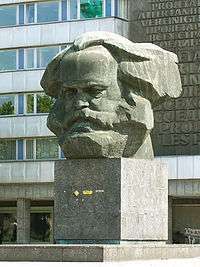Lev Kerbel


Lev Efimovich Kerbel (Russian: Лев Ефимович Кербель; November 7 [O.S. October 25] 1917 - 14 August 2003) was a renowned sculptor of Soviet realist works. Kerbel's creations included statues of Marx, Lenin, Yuri Gagarin, which were sent by Soviet Government as gifts to socialist and the Third World countries across the world.[1] In 1976 the Council of Ministers of the Soviet Union presented the Government of Sri Lanka the monument of Solomon Bandaranaike, the late Prime minister of the country, carved by Lev Kerbel.[2]
In 1990s following the collapse of the socialist block many of his works of art were destroyed. However his enormous Karl Marx monument in Chemnitz, formerly Karl-Marx-Stadt, has been preserved as a cultural monument.
Kerbel was born to a Russian Jewish family in the village of Semyonovka in Chernigov Governorate, Russian Republic (currently Semenivka, Chernihiv Oblast, Ukraine), on the day that Winter Palace in Petrograd was stormed by the Bolsheviks. Lev's family moved to the russian Smolensk region, where he began sculpting as a child. He continued to sculpt and in 1934 he won an award from the Komsomol (Young Communist League) for a plaque of Lenin.
During the World War II, Kerbel helped build the defenses for the Battle of Moscow, then served in the Northern Fleet, gaining renown as a military artist.
After the war, Kerbel's career took off with a wide range of commissions. In 1958 he sculpted a statue in Shanghai that depicted a huge Soviet and an equally large Chinese worker hand in hand. When Soviet-Chinese relations foundered a few years later, the statue was torn down by a mob.
In 1950-1970s Kerbel sculpted lots of portraits of Soviet and foreign intellectuals: writer Boris Lavrenyov and violinist David Oistrakh, Canadian clergyman James Gareth Endicott, Giacomo Manzù (sculptor) and Pietro Orgento (orchestra conductor) from Italy and many others.[2] Another example of Lev Kerbel's sculptures is the Lenin Monument in the Parque Lenin area of Havana, Cuba.
While some people dismiss Kerbel's works as a flat Communist propaganda, Kerbel himself claimed that he was always more interested in art than politics. Many people now view his few remaining statues with nostalgia, particularly in Chemnitz, where his bust of Karl Marx is referred to as 'the head.' Among the monuments on the graves of the Soviet soldiers carefully preserved in Germany the sculptures in Berlin, and on Seelow Heights were carved by Lev Kerbel.[1]
One of the last works of Kerbel was the Memorial to the crew of the “Kursk” submarine, opened in Moscow on August 12, 2002[3]
Honours and awards
- Hero of Socialist Labour (1985)
- Order of Merit for the Fatherland, 3rd class (5 November 1997) - for services to the state and personal contribution to the development of the national fine arts
- Order of Friendship of Peoples (6 May 1993) - for the great achievements in art, to strengthen international cultural relations and fruitful pedagogical activity
- Order of Lenin
- Order of the Red Banner of Labour
- Order of the Patriotic War, 2nd class
- Order of the Red Star
- Lenin Prize (1962) - a monument to Karl Marx Square named after Sverdlov, in Moscow (1961)
- Stalin Prize, 1st class (1950) - sculptural reliefs "Lenin and Stalin - founders and leaders of the Soviet state"
- People's Artist of USSR (1977)
- People's Artist of RSFSR (1967)
- Order of Karl Marx (East Germany)
- Goethe Prize winner (Germany)
- Medal "For the Defence of Moscow"
- Medal "For the Defence of the Soviet Transarctic"
- Medal "For the Capture of Berlin"
- Honorary Citizen of Smolensk and Polyarny
- Honorary Citizen of Karl-Marx-Stadt (presently Chemnitz)[2]
- Honorary Citizen of Sofia (Bulgaria)[4]
- Medal "For the Victory over Germany in the Great Patriotic War 1941–1945"
- Jubilee Medal "Twenty Years of Victory in the Great Patriotic War 1941-1945"
- Jubilee Medal "Thirty Years of Victory in the Great Patriotic War 1941-1945"
- Jubilee Medal "Forty Years of Victory in the Great Patriotic War 1941-1945"
- Jubilee Medal "50 Years of Victory in the Great Patriotic War 1941-1945"
- Jubilee Medal "60 Years of Victory in the Great Patriotic War 1941-1945"
| Wikimedia Commons has media related to Lew Kerbel. |
References
- 1 2 N. V. Voronov (ed.) (1977). Лев Ефимович Кербель (in Russian). Moscow: Izobrazitelnoye Iskusstvo Publishers.
- 1 2 3 N. V. Voronov (ed.) (1977). Лев Ефимович Кербель (in Russian). Moscow: Izobrazitelnoye Iskusstvo Publishers. p. 30.
- ↑ .rian.ru // В столице состоится открытие памятного знака в честь погибшего экипажа подлодки «Курск»
- ↑ N. V. Voronov (ed.) (1977). Лев Ефимович Кербель (in Russian). Moscow: Izobrazitelnoye Iskusstvo Publishers. p. 34.
